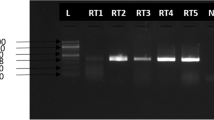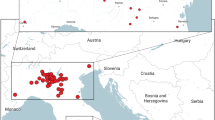Abstract
The hazel dormouse (Muscardinus avellanarius) population in the UK continues to decline due to habitat loss, despite reintroductions of captive-bred individuals being conducted nationally for over 30 years. Disease surveillance of captive-bred and wild dormice is performed to identify novel and existing disease threats which could impact populations. In this study, we firstly investigated cause of death in seven hazel dormice found dead in England, through next-generation sequencing identifying a virus closely related to a wood mouse encephalomyocarditis virus-2 (EMCV-2). Subsequently, lung tissue samples from 35 out of 44 hazel dormice tested positive for EMCV-2 RNA using a reverse transcriptase quantitative polymerase chain reaction (RT-qPCR) and Sanger sequencing methods developed in this study. Formalin-fixed tissues available for nine hazel dormice which tested positive for EMCV-2 RNA were examined microscopically. Three cases showed moderate interstitial pneumonia with minimal to mild lymphoplasmacytic myocarditis, but no evidence of encephalitis. However, the presence of possible alternative causes of death in these cases means that the lesions cannot be definitively attributed to EMCV-2. Here, we report the first detection of EMCV-2 in hazel dormice and conclude that EMCV-2 is likely to be endemic in the hazel dormouse population in England and may be associated with clinical disease.


Similar content being viewed by others
References
Amaddeo D, Cardeti G, Autorino GL (1995) Isolation of encephalomyocarditis virus from dormice (Myoxus glis) in Italy. J Wildl Dis 31. https://doi.org/10.7589/0090-3558-31.2.238
Billinis C (2009) Encephalomyocarditis virus infection in wildlife species in Greece. J Wildl Dis 45. https://doi.org/10.7589/0090-3558-45.2.522
Carocci M, Bakkali-Kassimi L (2012) The encephalomyocarditis virus. Virulence 3
Cerutis DR, Bruner RH, Thomas DC, Giron DJ (1989) Tropism and histopathology of the d, b, k, and mm variants of encephalomyocarditis virus. J Med Virol 29:63–69. https://doi.org/10.1002/jmv.1890290112
Edgar RC (2004) MUSCLE: Multiple sequence alignment with high accuracy and high throughput. Nucleic Acids Res 32:1792–1797. https://doi.org/10.1093/nar/gkh340
Fredricks DN, Relman DA (1996) Sequence-based identification of microbial pathogens: A reconsideration of Koch’s postulates. Clin Microbiol Rev 9
Goodwin CED, Hodgson DJ, Al-Fulaij N, Bailey S, Langton S, Mcdonald RA (2017) Voluntary recording scheme reveals ongoing decline in the United Kingdom hazel dormouse Muscardinus avellanarius population. Mamm Rev 47
Gould EA, de Lamballerie X, Coutard B, Fooks AR, Outlaw M, Drosten C, Guenther S, Klempa B, Pinschewer D, Avsic-Zupanc T, Sabeta C, Lukashev A, Eropkin M, Koslov A, Zverev V, Lvov D, Zhebrun A, Shipulin G, Niedrig M, Gao Fu G, Dong Liang G, Ippolito G, Koray E, Romette JL (2012) The European Virus Archive: A new resource for virology research. Antiviral Res 95
Helwig FC, Schmidt CCEH (1945) A filter-passing agent producing interstitial myocarditis in anthropoid apes and small animals. Science 1979:102. https://doi.org/10.1126/science.102.2637.31
Higuchi H, Hara M, Yamamoto K, Miyamoto T, Kinoshita M, Yamada T, Uchiyama K, Matsumori A (2008) Mast cells play a critical role in the pathogenesis of viral myocarditis. Circulation 118. https://doi.org/10.1161/CIRCULATIONAHA.107.741595
Kearse M, Moir R, Wilson A, Stones-Havas S, Cheung M, Sturrock S, Buxton S, Cooper A, Markowitz S, Duran C, Thierer T, Ashton B, Meintjes P, Drummond A (2012) Geneious basic: An integrated and extendable desktop software platform for the organization and analysis of sequence data. Bioinformatics 28:1647–1649. https://doi.org/10.1093/bioinformatics/bts199
Kishimoto C, Kuribayashi K, Masuda T, Tomioka N, Kawai C (1985) Immunologic behavior of lymphocytes in experimental viral myocarditis: Significance of T lymphocytes in the severity of myocarditis and silent myocarditis in BALB/c-nu/nu mice. Circulation 71. https://doi.org/10.1161/01.CIR.71.6.1247
People’s Trust for Endangered Species (2024) Hazel dormouse conservation. https://ptes.org/campaigns/dormice/hazel-dormouse-conservation/. Accessed 7 Feb 2024
Philipps A, Dauber M, Groth M, Schirrmeier H, Platzer M, Krumbholz A, Wutzler P, Zell R (2012) Isolation and molecular characterization of a second serotype of the encephalomyocarditis virus. Vet Microbiol 161. https://doi.org/10.1016/j.vetmic.2012.07.006
Psalla D, Psychas V, Spyrou V, Billinis C, Papaioannou N, Vlemmas I (2006) Pathogenesis of Experimental Encephalomyocarditis: A Histopathological, Immunohistochemical and Virological Study in Mice. J Comp Pathol 135. https://doi.org/10.1016/j.jcpa.2006.04.003
Qin S, Underwood D, Driver L, Kistler C, Diallo I, Kirkland PD (2018) Evaluation of a duplex reverse-transcription real-time PCR assay for the detection of encephalomyocarditis virus. Journal of Veterinary Diagnostic Investigation 30. https://doi.org/10.1177/1040638718779112
Rozen S, Skaletsky H (2000) Primer3 on the WWW for general users and for biologist programmers. Methods Mol Biol 132. https://doi.org/10.1385/1-59259-192-2:365
Seaman JT, Boulton JG, Carrigan MJ (1986) Encephalomyocarditis virus disease of pigs associated with a plague of rodents. Aust Vet J 63:292–294. https://doi.org/10.1111/j.1751-0813.1986.tb08069.x
Suvarna SK, Layton C, Bancroft JD (2019) Bancroft’s theory and techniques of histological practice
Tamura K, Stecher G, Kumar S (2021) MEGA11: Molecular Evolutionary Genetics Analysis Version 11. Mol Biol Evol 38. https://doi.org/10.1093/molbev/msab120
Vyshemirskii OI, Agumava AA, Kalaydzyan AA, Leontyuk A V., Kuhn JH, Shchetinin AM, Vishnevskaya T V., Eremyan AA, Alkhovsky S V. (2018) Isolation and genetic characterization of encephalomyocarditis virus 1 from a deceased captive hamadryas baboon. Virus Res 244. https://doi.org/10.1016/j.virusres.2017.11.001
Wang Y, Toh X, Ng OW, Ong J, Chong SM, Hsu C-D, Huangfu T (2019) Genbank MN547968. https://www.ncbi.nlm.nih.gov/nuccore/MN547968. Accessed 19 Feb 2024
Wobeser GA (2007) Disease in wild animals: Investigation and management
Wu Z, Han Y, Liu B, Li H, Zhu G, Latinne A, Dong J, Sun L, Su H, Liu L, Du J, Zhou S, Chen M, Kritiyakan A, Jittapalapong S, Chaisiri K, Buchy P, Duong V, Yang J, Jiang J, Xu X, Zhou H, Yang F, Irwin DM, Morand S, Daszak P, Wang J, Jin Q (2021) Decoding the RNA viromes in rodent lungs provides new insight into the origin and evolutionary patterns of rodent-borne pathogens in Mainland Southeast Asia. Microbiome 9. https://doi.org/10.1186/s40168-020-00965-z
Zimmerman JJ, Karriker LA, Ramirez A, Schwartz KJ, Stevenson GW, Zhang J (2019) Diseases of swine
Disclaimer
Author Anthony W. Sainsbury is a listed Editor for EcoHealth
Funding
The authors declared financial support for the research from Natural England (Agreement number Ecm 65292), People’s Trust for Endangered Species, the Royal Veterinary College and the Animal and Plant Health Agency. The authors declared no financial support for the authorship and/or publication of this article.
Author information
Authors and Affiliations
Corresponding author
Ethics declarations
Conflict of Interests
The authors declared no potential conflicts of interest with respect to the research, authorship and/or publication of this article.
Ethical Approval
A non-ethical declaration form was submitted and approved by Institute of Zoology, Zoological Society of London.
Supplementary Information
Below is the link to the electronic supplementary material.
Rights and permissions
Springer Nature or its licensor (e.g. a society or other partner) holds exclusive rights to this article under a publishing agreement with the author(s) or other rightsholder(s); author self-archiving of the accepted manuscript version of this article is solely governed by the terms of such publishing agreement and applicable law.
About this article
Cite this article
Gibson, L., Shadbolt, T., Paul, P. et al. Prevalence and Molecular Analysis of Encephalomyocarditis Virus-2 in the Hazel Dormouse. EcoHealth (2024). https://doi.org/10.1007/s10393-024-01680-z
Received:
Revised:
Accepted:
Published:
DOI: https://doi.org/10.1007/s10393-024-01680-z




